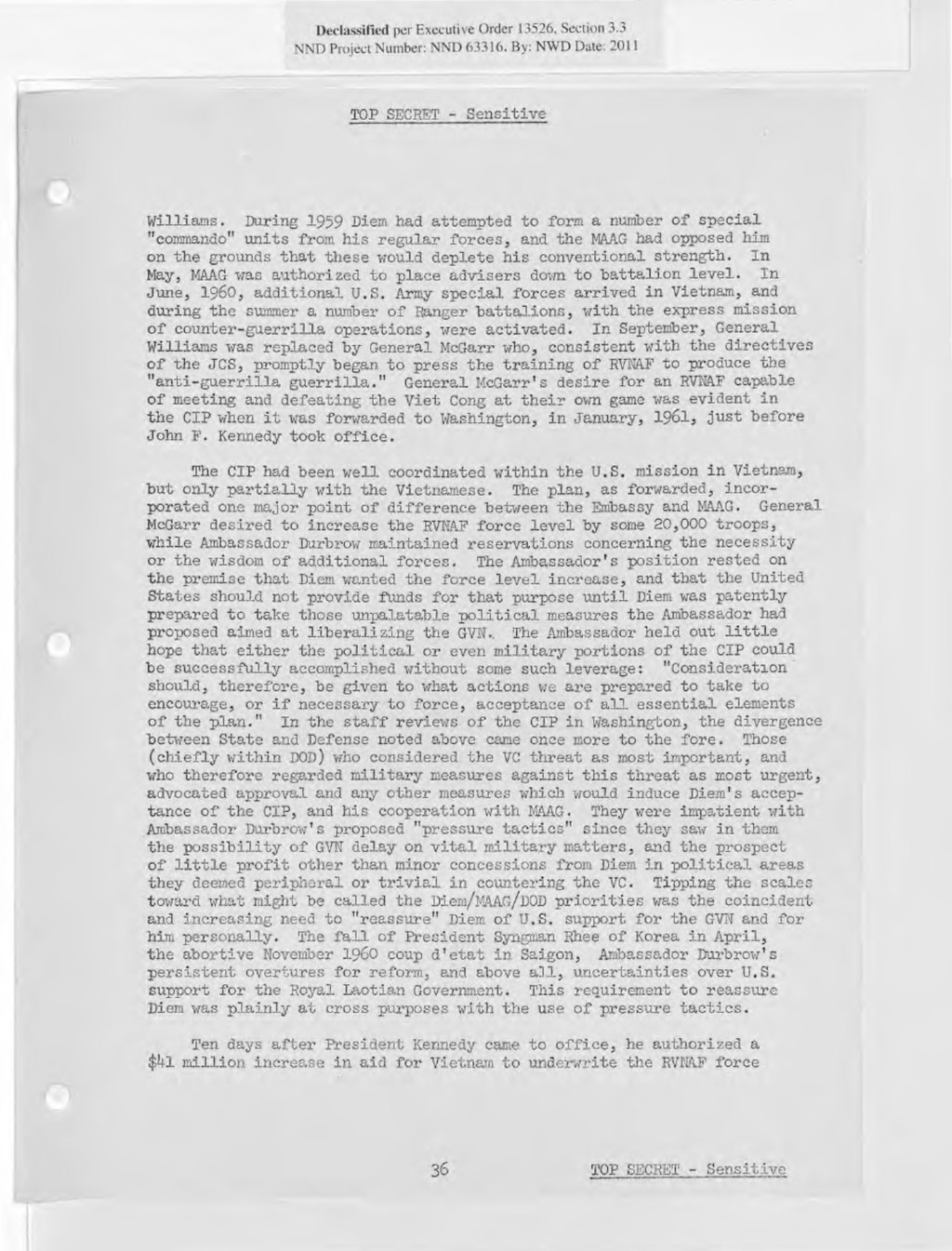Declassified per Executive Order 13526, Section 3.3
NND Project Number: NND 63316. By: NWD Date: 2011
TOP SECRET – Sensitive
Williams. During 1959 Diem had attempted to form a number of special "commando" units from his regular forces, and the MAAG had opposed him on the grounds that these would deplete his conventional strength. In May, MAAG was authorized to place advisers down to battalion level. In June, 1960, additional U.S. Army special forces arrived in Vietnam, and during the summer a number of Ranger battalions, with the express mission of counter-guerrilla operations, were activated. In September, General Williams was replaced by General McGarr who, consistent with the directives of the JCS, promptly began to press the training of RVNAF to produce the "anti-guerrilla guerrilla." General McGarr's desire for an RVNAF capable of meeting and defeating the Viet Cong at their own game was evident in the CIP when it was forwarded to Washington, in January, 1961, just before John F. Kennedy took office.
The CIP had been well coordinated within the U.S. mission in Vietnam, but only partially with the Vietnamese. The plan, as forwarded, incorporated one major point of difference between the Embassy and MAAG. General McGarr desired to increase the RVNAF force level by some 20,000 troops, while Ambassador Durbrow maintained reservations concerning the necessity or the wisdom of additional forces. The Ambassador's position rested on the premise that Diem wanted the force level increase, and that the United States should not provide funds for that purpose until Diem was patently prepared to take those unpalatable political measures the Ambassador had proposed aimed at liberalizing the GVN. The Ambassador held out little hope that either the political or even military portions of the CIP could be successfully accomplished without some such leverage: "Consideration should, therefore, be given to what actions we are prepared to take to encourage, or if necessary to force, acceptance of all essential elements of the plan." In the staff reviews of the CIP in Washington, the divergence between State and Defense noted above came once more to the fore. Those (chiefly within DOD) who considered the VC threat as most important, and who therefore regarded military measures against this threat as most urgent, advocated approval and any other measures which would induce Diem's acceptance of the CIP, and his cooperation with MAAG. They were impatient with Ambassador Durbrow's proposed "pressure tactics" since they saw in them the possibility of GVN delay on vital military matters, and the prospect of little profit other than minor concessions from Diem in political areas they deemed peripheral or trivial in countering the VC. Tipping the scales toward what might be called the Diem/MAAG/DOD priorities was the coincident and increasing need to "reassure" Diem of U.S. support for the GVN and for him personally. The fall of President Syngman Rhee of Korea in April, the abortive November 1960 coup d'etat in Saigon, Ambassador Durbrow's persistent overtures for reform, and above all, uncertainties over U.S. support for the Royal Laotian Government. This requirement to reassure Diem was plainly at cross purposes with the use of pressure tactics.
Ten days after President Kennedy came to office, he authorized a $41 million increase in aid for Vietnam to underwrite the RVNAF force
